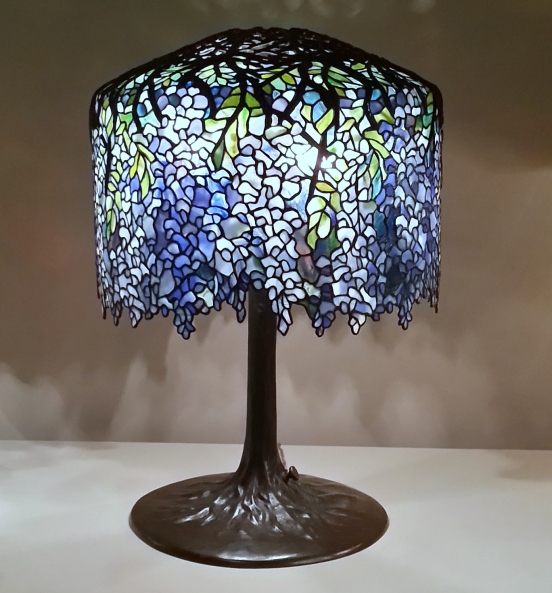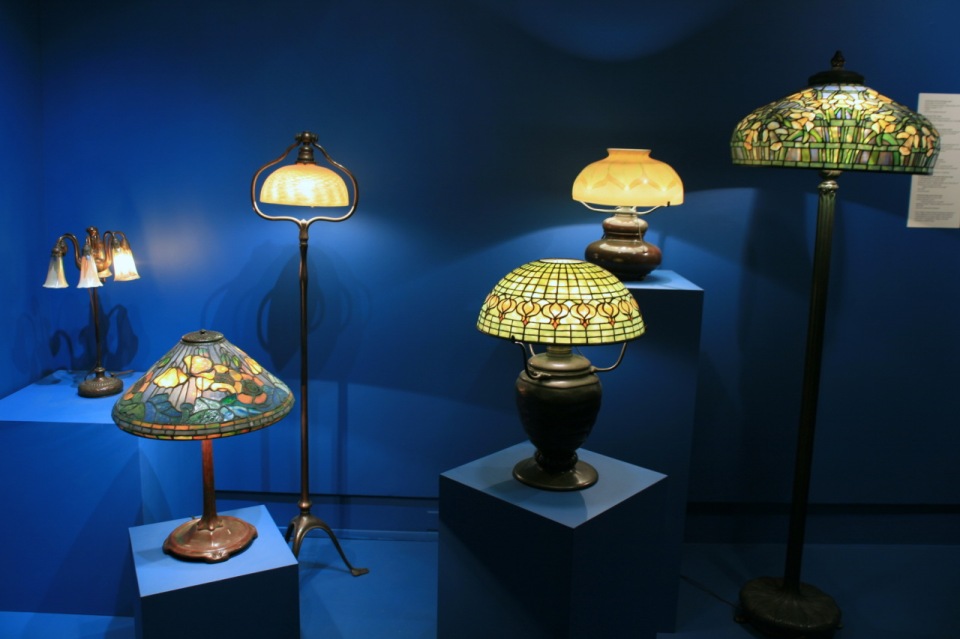At the turn of the 19th century, a sorority of female workers in Queens labored anonymously to create the fabulous Tiffany lamps. Known as the Tiffany Girls, these artisans meticulously created lamps that wed the new invention of the electric light bulb with fine craftsmanship. The Tiffany lamp became a trope for the combination of American manufacturing ingenuity and fine design.

Wisteria table lamp designed by Clara Driscoll for Tiffany Studios, ca. 1902. Collection of the Virginia Museum of Fine Arts. Photo by Fopseh via Wikimedia Commons.
The beautiful mosaic glass lamps the Tiffany Girls created lit the living rooms of America’s Gilded Age. This term, a reference to a thin coating of gold covering a core of base metal, was coined by Mark Twain as a criticism of the hidden inequalities of the era. The contributions of these anonymous Ladies of Light to American decorative arts were finally acknowledged in 2007. A New Light on Tiffany, an exhibition at the New-York Historical Society, shed new and long-overdue light on the artistic genius of chief designer, Clara Driscoll and her female crew of artisans.
A New Light on Tiffany celebrated the genius of these women while offering insight into work life of women in the Corona, Queens Tiffany Studios in turn-of-the-century New York. This included the difficulties of being a woman in a man’s world—including the convention of the time banning married women from employment at Tiffany Studios.

Clara Driscoll with Joseph Briggs, a longtime Manager at Tiffany Studios, ca. 1901. Photo in the collection of the Metropolitan Museum of Art.
A native of Ohio, Clara Pierce Wolcott was born in 1861, the year the Battle of Bull Run began the Civil War. Clara moved to New York, and enrolled in the new school at the Metropolitan Museum of Art. She found employment at Tiffany Studios during a strike by the men of the Lead Glaziers and Glass Cutters Union.
Tiffany Studios hired large numbers of women to cut glass in the Corona, Queens complex they opened next to Tiffany Glass Furnaces. The Queens location was far from prying eyes seeking to uncover the methods by which Louis Comfort Tiffany manufactured glass of dazzling colors and effects. In Queens, Clara Driscoll and her team of skilled women artisans labored to produce Tiffany’s intricate lamps.
Driscoll became the head of the Women’s Glass Cutting Department in 1894. She worked for Tiffany Studios for more than two decades, creating some of their most iconic designs–anonymously–as was thought to befit her status as a woman.

A display of Tiffany table and floor lamps. Collection of the Mark Twain House and Museum. Photo by Magnus Manske via Wikimedia Commons.
Clara Driscoll and the Tiffany Girls worked on lamp shades composed of hundreds of pieces of cut glass, from Tiffany’s repertoire of decorative glass. Tiffany’s manufacturing process was to use cartoons to cut out brass templates. These would be used as guides to cut hundreds of individual pieces of glass. Each glass piece was edged in copper foil. The shade would then be assembled on a rounded wooden form, and the glass pieces soldered together with lead. The result was a shade that allowed light from an electric bulb to both bring brightness to the room and illuminate the colored glass.

Tiffany workbench with cartoon, wooden form, copper foil and soldering iron, 1900-1907. Collection of the Metropolitan Museum of Art. Gift of Fred and Nancylee Dikeman, in memory of his father, John Dikeman, 1980.
Tiffany became famous for the color-infused, leaded glass lampshades that have come to define his name. But it was Clara Driscoll and the Tiffany girls, not Tiffany and his staff of male designers, who both designed and executed some of Tiffany Studio’s most successful designs. The women have been linked specifically to lamps with natural motifs, including the famous dragonfly, arrowhead, daffodil and wisteria lamps, arguably among the most iconic Tiffany products ever produced.

Dragonfly table lamp designed by Clara Driscoll for Tiffany Studios, 1920. Collection of Dayton Art Institute. Photo by Wmperal via Wikimedia Commons.
Driscoll and the Ladies of Light labored anonymously. Americans believed, incorrectly, that the designs for the famous lamps were the genius of Louis Comfort Tiffany, a belief he was happy to encourage. Professor Mark Eidelburg is an expert on Tiffany who lectures at Rutgers University. He was asked how he felt Louis Comfort Tiffany would have reacted to the recent acknowledgement that Clara Driscoll, a woman, and not Tiffany himself had designed some of his most famous lamps. Professor Eidelberg’s response was succinct: “I think Tiffany would have died.”
The Professor’s point is well taken as Tiffany, buried in Brooklyn’s Green-Wood Cemetery, chose a simple stone monument for his own grave. Nearby, the mausoleum of Gilded Age “Copper King” Marcus Daly (1841-1900) features spectacular Tiffany windows—likely designed and executed by Clara Driscoll and her team of women at Tiffany Studios.

Stained glass window from Tiffany Studios in the mausoleum of Marcus Daly, Green-Wood Cemetery, Brooklyn, NY. Photo courtesy Mille Fiori Favoriti.
In 1937, following changing tastes and the effects of the Great Depression, the Corona factory closed. In March 2013, bulldozers began wrecking the old Tiffany building to make way for a new elementary school. Thousands of shards of Tiffany glass were uncovered, their fabulous colors and effects revealed by the light for the first time in decades.
Carefully excavated, then cleaned and sorted, the glass was used by artist Rita McBride to create a modernist frieze in the new school. Says McBride: “I’m excited to be using actual Tiffany glass pieces that were manufactured here.” Public School 315Q, constructed on the spot where Clara Driscoll and the Tiffany Girls labored anonymously to create the famous Tiffany lamps, is known as The Tiffany School.

Rita McBride
Artifacts (C.W.D.) 2015
Excavated Tiffany glass shards installed within an aluminum PK-30 System
Collection of the NYC Department of Education
© Rita McBride, photo: Joerg Lohse, courtesy Alexander and Bonin, New York.

